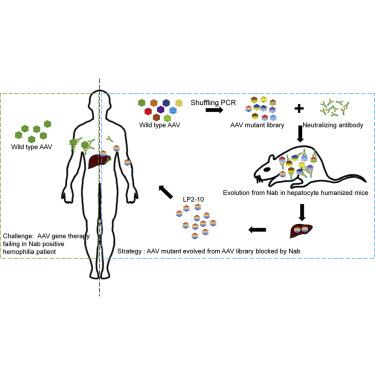Molecular Therapy - Methods & Clinical Development ( IF 4.6 ) Pub Date : 2020-06-03 , DOI: 10.1016/j.omtm.2020.06.003 Xiaolei Pei 1, 2 , Wenwei Shao 2 , Allene Xing 2 , Charles Askew 2 , Xiaojing Chen 2 , Caibin Cui 3 , Yasmina L Abajas 4 , David A Gerber 3 , Elizabeth P Merricks 5 , Timothy C Nichols 5 , Wuping Li 6 , R Jude Samulski 2, 7 , Chengwen Li 2, 4, 8

|
Adeno-associated virus (AAV) vectors have been successfully used in patients with bleeding disorders and blindness. For human liver targeting, two major factors restrict effective AAV transduction after systemic administration of AAV vectors: human hepatocyte tropism and neutralizing antibodies (Nabs). In this study, we attempted to isolate AAV variants with the ability to transduce human hepatocytes and escape Nabs using a directed evolution approach in vivo. After four cycles of selection, 14 AAV capsid mutants were identified from a capsid shuffling library selected in the presence of human Intravenous Immunoglobulin (IVIG) and isolated from human hepatocytes xenografted into chimeric mice. AAV neutralization assays using IVIG showed that most of the mutants showed the Nab escape pattern in a manner similar to that of AAV8 or AAV9 and better than that of other AAV serotypes. Different mutants displayed varying capacities to escape Nab activity from individual serum samples collected from healthy subjects or hemophilia patients. The mutant AAV LP2-10 was found in 12 colonies out of 25, which was composed of capsids from AAV serotypes 2, 6, 8, and 9, with VP3 subunits derived from AAV8 swapped with AAV6 from residues 261 to 272. The mutant AAV LP2-10 manifested a higher ability than that of other serotypes to escape Nabs in IVIG and most human serum samples. After injection of AAV vectors encoding a self-complementary GFP cassette into chimeric mice, LP2-10 transduced human hepatocytes with efficiency similar to that of AAV8. In summary, AAV mutants can be isolated in humanized mice with both human hepatocyte tropism and the ability to evade Nab activity.
中文翻译:

具有人肝细胞向性和中和抗体逃逸能力的 AAV 变体的开发。
腺相关病毒(AAV)载体已成功用于治疗出血性疾病和失明患者。对于人肝脏靶向,全身施用 AAV 载体后,有两个主要因素限制了 AAV 有效转导:人肝细胞向性和中和抗体 (Nab)。在这项研究中,我们尝试使用体内定向进化方法分离出能够转导人类肝细胞并逃脱 Nab 的 AAV 变体。经过四个周期的选择后,从在人静脉免疫球蛋白(IVIG)存在下选择的衣壳改组文库中鉴定出14个AAV衣壳突变体,并从异种移植到嵌合小鼠中的人肝细胞中分离出来。使用 IVIG 的 AAV 中和测定表明,大多数突变体以与 AAV8 或 AAV9 相似的方式显示 Nab 逃逸模式,并且优于其他 AAV 血清型。不同的突变体表现出不同的逃避来自健康受试者或血友病患者的个体血清样本的 Nab 活性的能力。在 25 个菌落中的 12 个菌落中发现了突变型 AAV LP2-10,该菌落由 AAV 血清型 2、6、8 和 9 的衣壳组成,其中来自 AAV8 的 VP3 亚基从残基 261 到 272 与 AAV6 交换。在 IVIG 和大多数人血清样本中,LP2-10 表现出比其他血清型更高的逃避 Nab 的能力。将编码自互补 GFP 盒的 AAV 载体注射到嵌合小鼠体内后,LP2-10 转导人肝细胞的效率与 AAV8 相似。总之,可以在人源化小鼠中分离出 AAV 突变体,该突变体具有人类肝细胞向性和逃避 Nab 活性的能力。











































 京公网安备 11010802027423号
京公网安备 11010802027423号